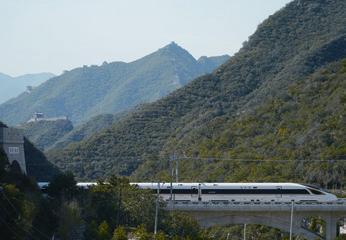For a Green Olympic
2020-11-20ByTaoZihui
By Tao Zihui

‘Let Zhangbeis wind light up Beijing.” This used to be the slogan of a renewable energy project, a major scheme to provide clean energy during the Beijing 2022 Olympic Winter Games. Zhangbei, a county in Hebei Province in north China, is one of the four places where power stations were built to convert wind, solar and other green energies into fl exible direct current.
On June 29, after three years of construction, the project, the fi rst of its kind in the world, went into operation. Electricity generated by clean sustainable sources in Zhangbei was transmitted to Beijing, lighting up select venues in the capital.
The new grid has been built using home-grown core technologies. It can deliver 14 billion kWh of clean electricity every year, which will meet the needs of 26 Winter Olympics venues in Beijing and co-host city Zhangjiakou in Hebei. Beijing 2022 will be the fi rst Winter Olympics to be solely powered by green energy.
Green commitment
Since Beijing won the bid five years ago to host the Winter Games, the focus has been on eco-friendly solutions not only for the planned 17 days of competitions but also to harness the green drive for national development.
In recent years, reducing carbon dioxide emissions has become an urgent requirement for all major sports competitions. In the past, such events usually achieved carbon neutrality through forestry management, energy conservation and emission reduction. Beijing 2022 will do more.
During a UN General Assembly debate on sports for development and peace in December 2019, Zhang Jun, Chinas Permanent Representative to the UN, reaffi rmed the promise that green energy will be used in all Olympic venues in 2022 to strive for carbon neutrality.
“We will hold a green Olympic Games and prioritize ecological consideration, resources conservation and environmental friendliness by developing and implementing a low-carbon management work plan,”Zhang said.
The Carbon Management Plan for the Olympic and Paralympic Winter Games Beijing 2022, released in June 2019, provides an institutional underpinning for hosting the Winter Games in a green manner. It encourages a low-carbon lifestyle, ecological progress, innovations and setting an example in response to climate change, as stated in the bid commitment.
The plan gives priority to building lowcarbon and green venues. The National Speed Skating Oval in downtown Beijing, popularly known as Ice Ribbon, is an example of green construction.
Built on what was the archery field in the 2008 Olympic Summer Games, the oval will be the fi rst large venue in the world to use carbon dioxide as a cooling agent to create a 12,000-square-meter ice surface for speed skating. Generally, rinks used the organic compound Freon, which is said to be harmful for the environment.
The Beijing 2022 organizing committee announced last year that it would be using natural carbon dioxide refrigeration systems in its ice venues, as it joined the UN Sports for Climate Action, a framework to persuade the global sports community to support climate goals.
“This is a landmark decision which could potentially help address the issue of climate change, both in China and even globally,” said Juan Antonio Samaranch, Chair of the Coordination Commission for Beijing 2022 of the International Olympic Committee (IOC). “We are pleased to see that the IOCs close collaboration with Beijing 2022 has resulted in such an important outcome.”
Natural carbon dioxide refrigerants, which have no impact on the environment, will be used in the Beijing 2022 speed skating, fi gure skating and short track venues, as well as the ice hockey training venues, according to the organizers.
This will be the first time the technology is used in China and at the Olympic Games. It will lead to a reduction in carbon dioxide emissions equal to the yearly footprint of almost 3,900 cars. A similar carbon reduction can be achieved if more than 1.2 million trees are planted.
“Compared with the traditional refrigeration system, the ice-making efficiency will be increased by 30 percent and the effect will be better. At the same time, it can save 2 million kWh of clean electricity every year,” Ma Jin, an engineer in charge of ice-making at the oval, told Xinhua News Agency.

The oval is also using other innovative energy-conservation and low-carbon emission techniques. The heat generated while making ice with carbon dioxide can be used for heating and providing hot water. The solar photoelectric fi lm on its roof can generate power while its innovative steel structure design has cut down steel usage by 25 percent, according to Wu Xiaonan, Chairman of Beijing National Speed Skating Oval Operation Co. Ltd.
Seamless adaptation
Beijing has taken a “Chinese approach”to the development of the 2022 Winter Olympics, that is to say, adapting the Games to the citys development.
The IOCs new policy is that the cities hosting the Games will be given greater flexibility so that the process meets their own long-term development goals and they get more assistance from the wider Olympic movement.
“The Games have to fi t to the context, and not the context to the Games”—this has been IOC Sports Director and Deputy Olympic Games Executive Director Christophe Dubis assertion. He said this once again at the opening ceremony of the World Winter Sports (Beijing) Expo 2020 in Beijing in September.
According to Liu Xinping, an offi cial with the Beijing 2022 organizing committee, Beijing 2022s priority has been ecological protection during the whole process of venue planning, construction and operation. This will also be continued during the post-Olympic utilization of the venues. Construction and renovation projects have followed green standards.
Xiaohaituo Mountain in Yanqing, a district in Beijing, is where the venues for the Alpine skiing, bobsleigh, skeleton and luge events are located. During the construction of the National Alpine Skiing Center and the National Sliding Center, protecting biodiversity on the 2,000-meter mountain was the priority.
According to Liu Lifeng, Director of Venue Construction Office in Yanqing, a pre-construction evaluation was carried out, leading to an ecological restoration plan and protection measures for the animals and plants in the construction area.
Temporary migration paths for animals were opened and work time was cut short during the first phase of construction to ensure the animals could migrate freely and safely.
While building the Yanqing Olympic Village for athletes, workers managed to preserve as many trees on-site as possible. Based on a pre-construction evaluation, more than 24,000 trees were transplanted from the mountain ridges where the ski slopes and sled courses were built.
“We adopted effective ecological restoration measures and made full use of the areas own resources to minimize human disturbance and integrate the venues with nature,” Liu Lifeng told Xinhua.
